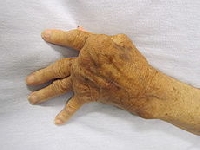Rheumatoid arthritis how do you cope?
Launch gallery slideshow

| Swap Coordinator: | reauk (contact) |
| Swap categories: | |
| Number of people in swap: | 2 |
| Location: | International |
| Type: | Type 1: Electronic |
| Rating requirement: | 4.90 (unrated swappers allowed) |
| Last day to signup/drop: | June 14, 2013 |
| Date items must be sent by: | June 19, 2013 |
| Number of swap partners: | 10 |
| Description: | |
|
iv suffered Rheumatoid arthritis for many a year now I thought we could swap how we cope day to day. e/mail swap so its free any questions please pm me you can pm or e/mail your answers. Rheumatoid arthritis (RA) is a chronic systemic inflammatory disease of unknown cause. An external trigger (eg, cigarette smoking, infection, or trauma) that triggers an autoimmune reaction, leading to synovial hypertrophy and chronic joint inflammation along with the potential for extra-articular manifestations, is theorized to occur in genetically susceptible individuals. Essential update: Tofacitinib effective treatment for RA Researchers demonstrated the efficacy of tofacitinib in 797 RA patients with inadequate responses to methotrexate in a phase III trial in which patients were randomly assigned to receive tofacitinib 5 or 10 mg, or placebo twice daily. All placebo patients were switched to tofacitinib at 6 months. ACR20 response rates (20% improvement in tender or swollen joint counts and 20% improvement in 3 of these 5 criteria: acute phase reactant, patient assessment, physician assessment, pain scale, and disability/functional questionnaire at 6 months) were significantly higher for both tofacitinib doses compared with placebo, as were ACR50 and ACR70 response rates. Structural preservation at 12 months and the proportion of patients with no radiographic progression at 6 and 12 months were significantly better for both tofacitinib doses than for placebo.[1, 2] Signs and symptoms In most patients with RA, onset is insidious, often beginning with fever, malaise, arthralgias, and weakness before progressing to joint inflammation and swelling. Signs and symptoms of rheumatoid arthritis may include the following: • Persistent symmetric polyarthritis (synovitis) of hands and feet (hallmark feature) • Progressive articular deterioration • Extra-articular involvement • Difficulty performing activities of daily living (ADLs) • Constitutional symptoms The physical examination should address the following: • Upper extremities (metacarpophalangeal joints, wrists, elbows, shoulders) • Lower extremities (ankles, feet, knees, hips) • Cervical spine During the physical examination, it is important to assess the following: • Stiffness • Tenderness • Pain on motion • Swelling • Deformity • Limitation of motion • Extra-articular manifestations • Rheumatoid nodules Guidelines for evaluation • 2010 American College of Rheumatology (ACR)/European League Against Rheumatism (EULAR) classification criteria[3] • 2012 ACR disease activity measures[4] • 2011 ACR/EULAR definitions of remission[5] See Clinical Presentation for more detail. Diagnosis No test results are pathognomonic; instead, the diagnosis is made by using a combination of clinical, laboratory, and imaging features. Potentially useful laboratory studies in suspected RA include the following: • Erythrocyte sedimentation rate • C-reactive protein level • Complete blood count • Rheumatoid factor assay • Antinuclear antibody assay • Anti−cyclic citrullinated peptide and anti−mutated citrullinated vimentin assays Potentially useful imaging modalities include the following: • Radiography (first choice): Hands, wrists, knees, feet, elbows, shoulders, hips, cervical spine, and other joints as indicated • Magnetic resonance imaging: Primarily cervical spine • Ultrasonography of joints: Joints, as well as tendon sheaths, changes and degree of vascularization of the synovial membrane, and even erosions Joint aspiration and analysis of synovial fluid may be considered, including the following: • Gram stain • Cell count • Culture • Assessment of overall appearance See Workup for more detail. Management Nonpharmacologic, nonsurgical therapies include the following: • Heat and cold therapies • Orthotics and splints • Therapeutic exercise • Occupational therapy • Adaptive equipment • Joint-protection education • Energy-conservation education Guidelines for pharmacologic therapy • 2012 updates to 2008 ACR recommendations for use of nonbiologic and biologic disease-modifying antirheumatic drugs (DMARDs) • 2007 Agency for Healthcare Research and Quality (AHRQ) recommendations Nonbiologic DMARDS include the following: • Hydroxychloroquine • Azathioprine • Sulfasalazine • Methotrexate • Leflunomide • Cyclosporine • Gold salts • D-penicillamine • Minocycline Biologic TNF-inhibiting DMARDs include the following: • Etanercept • Infliximab • Adalimumab • Certolizumab • Golimumab Biologic non-TNF DMARDs include the following: • Rituximab • Anakinra • Abatacept • Tocilizumab • Tofacitinib Other drugs used therapeutically include the following: • Corticosteroids • Nonsteroidal anti-inflammatory drugs (NSAIDs) • Analgesics Surgical treatments include the following: • Synovectomy • Tenosynovectomy • Tendon realignment • Reconstructive surgery or arthroplasty • Arthrodesis | |
Discussion
Leave a Comment
You must be logged in to leave a comment. Click here to log in.
- Info:
- Home
- |
- About
- |
- Forum Rules
- |
- Terms of Use
- |
- Press
- |
- Advertising
- |
- Blog
- |
- Graphics & Stuff
- Help:
- New User Info
- |
- FAQ
- |
- Group Info
- |
- Glossary
- |
- Forums
- |
- |
- Contact Admin

